Have you ever looked into the autumn sky and observed the moon? In this story, Little Star and her Mama bake a big, round, wonderful mooncake together, and place it in the sky. As the mooncake rises and Little Star lies awake in her cozy bed, she can’t resist the temptation to tiptoe closer and take a little nibble. Her continued nighttime visits produce a trail of crumbs that engage the reader and beautifully illustrate the different phases of the moon. Little Star’s quiet adventure will leave readers wishing for a mooncake of their very own.
You are here
A Baker's Dozen: The Best Children's Books for Family Literacy
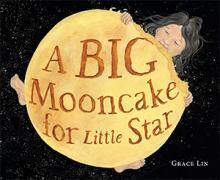
A Big Mooncake for Little Star
Tips for Using with Children
Adults can set the stage for some magical conversations by connecting this story to children’s experiences. Prior to reading together, adults can talk to children about the different phases of the moon. After reading, children might enjoy extending the story by drawing pictures of the different phases they noticed in the story. Adults can ask children if they ever noticed the moon in any of these phases, and children will be excited to observe the moon at home and predict what it might look like next.
Tips for Using with Families
This story provides a wonderful opportunity for children to use props to tell a story. Using a round cookie, pancake, or even a mooncake of your own, children can nibble along with Little Star as she changes the shape of her mooncake in the story. Parents can connect the illustrations to real life by peeking outside at night and comparing the moon they see to the different phases of the moon in the book.
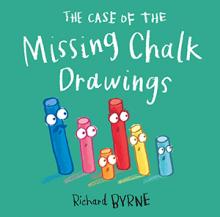
The Case of the Missing Chalk Drawings
There is a mystery to be solved, and Sergeant Blue is on the case! The chalks are distraught when they discover that their drawings have been stolen. Sergeant Blue offers to assist and collects evidence that eventually leads the chalks to the robber. This funny read aloud has such vibrant illustrations that it makes the reader want to brush the chalk dust off the pages. Creative problem-solving eventually captures the thief, but the motivation behind the crime prompts a compassionate turn of events. Despite its contents, this book won’t collect any dust on your shelves!
Tips for Using with Children
Adults can introduce the parts of a story during this fun read. Children will be eager to share ideas about the characters, the introduction, the problem, the evidence, and the (surprising) solution. Adults can respond to children’s ideas and model how to organize them by writing them on paper. In addition, chalk is a fun addition to classroom writing materials.
Tips for Using with Families
When reading this book together, parents can use the word “stolen” to describe the missing chalk drawings instead of the word “erased” to keep the excitement building and encourage children to solve the mystery at hand. By pointing to the pictures of the suspects, parents can direct children’s attention to the different characteristics of each one in more detail. After reading, parents and children can take turns sharing memories about their experiences using chalk and erasers, and brainstorm games and activities they can play together.
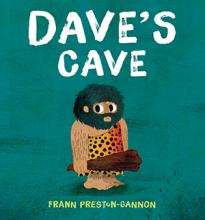
Dave’s Cave
Dave is a likeable caveman who loves the green grass and big comfy rocks that make his home. That is, unless, there is a better cave out there with greener grass and bigger rocks. In humorous caveman language, this story follows Dave as he seeks out a better home. Readers can relate as Dave explores the characteristics of different caves and realizes, at long last, that there just may be no place like home. This book is perfect for a fun read with a meaningful message.
Tips for Using with Children
Dave’s Cave is a fun read aloud. Children can practice their cave person voices. On a repeated reading, invite the children to join in. On some pages, point to the words to direct children’s eyes to the print. Be sure to help the children notice and read the drawings on the cave wall. As an extension activity, children can draw pictures of what they would like on the walls of their perfect cave homes.
Tips for Using with Families
Talk about questions that parents may want to ask the children while reading about Dave’s journey to find the perfect cave. Why didn’t he like his own cave? What did Dave take with him, and what would you take with you? Engage the children in a discussion about what isn’t quite right about each cave that Dave considers. Parents and children may also discuss Dave’s cave-person speech and have fun acting it out together.

Fox + Chick: The Party and Other Stories
Fox and Chick, a pair of unlikely friends, embark on a series of adventures in this book, which is separated into three brief and entertaining chapters: The Party, Good Soup, and Sit Still. In each chapter, the two friends interact using a comic book panel format that is accessible and engaging to young readers. The humorous dialogue between the two characters will have readers wanting to read more. The two companions may not always see eye to eye, but their friendship rises above their differences.
Tips for Using with Children
Because this is a chapter book, it presents an opportunity to prepare for reading longer books. Point out some of these characteristics prior to reading the story: Table of Contents, page numbers beside Chapter Titles, Title pages preceding each chapter. After reading one chapter, introduce the idea of using a bookmark to remember your place in a book. Children will enjoy making and decorating their own bookmarks. Encourage children to use them with books in the class library. They can mark where they stopped reading a story, or just mark a favorite page or picture that they want to return to. Of course, there is much to enjoy and talk about as you read these short, funny stories to children. And because Fox and Chick often misunderstand one another, these also become lessons in understanding another person’s point of view. For example, in the first story, consider what “use” your bathroom meant to Fox vs. why Chick wanted to “use” the bathroom.
Tips for Using with Families
Take this opportunity to introduce your child to chapter books. On reading the book’s title, emphasize the words “and other stories,” pointing out that this book contains more than one story. Then turn to the Contents and read the titles of each of the chapters, pointing out the page numbers and the pictures beside them. As your child names the pictures, you might want to wonder together what those pictures might have to do with the stories. Show your child how to find where each story starts using the page numbers listed. If your child is still a beginning listener, read just one chapter at a time. You can start at the beginning or let your child decide which story to hear first. The chapters are short and always funny, providing a great way to build any child’s attention span.
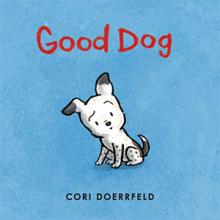
Good Dog
Brave. Happy. Loyal. Gentle. When the stray pup in this story sets his eyes (and heart) on a little girl and her mother, readers can’t help but cheer him on as he follows them through their daily tasks. Not everyone he encounters sees him as a good dog, but the reader is privy to all of his wonderful qualities. Each of his emotions and qualities are connected to illustrations that draw readers in and prompt meaningful discussion. At the end of the story, “stray dog” becomes “my dog,” as he joins the family he loves so much. Just as the dog in this story secures a home, Good Dog will secure a spot on your list of favorite books.
Tips for Using with Children
With just two words per page, and one of them being, “dog,” children will easily join in during repeated readings of this sweet story; and they may even want to read the book independently. You can extend this story into a writing and drawing activity by looking back through the book while pointing out some of the words the author used to describe the dog’s traits (brave) or feelings (lonely). How do the pictures help illustrate this? Explore words that might describe a dog—friendly, excited, afraid, etc. Encourage children to draw a dog, and then help them write a descriptive label for their picture. Share finished pictures with one another, post them or collect them into a book for children to look at and read.
Tips for Using with Families
Point out that in picture books, stories often begin before the first words appear. This is one of those books, so remind parents to encourage children to observe the pictures in the beginning endpapers, dedication, and title pages. These pictures set the stage, physically and emotionally, for the story that follows. After you finish reading the story, compare and talk about the front and back endpapers. Though this book has few words per page, much of the story is told in the pictures, so be sure to take time to talk about what’s happening and how the dog and little girl are feeling.
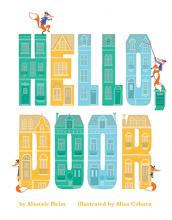
Hello, Door
A delightful twist on the traditional tale of Goldilocks and the Three Bears, Hello, Door introduces the reader to a thieving fox, who slinks his way through an empty house, greeting the goodies he snatches along the way. With simple yet humorous text and rhyme, readers witness Fox successfully collecting his treasures, until he unexpectedly comes face-to-face with the homeowners. Does Fox learn his lesson when caught in the act? Hello, cliffhanger!
Tips for Using with Children
Allow children time to peruse the pictures as you read this story. Let them enjoy the rhymes and join in with the reader wherever they can. At the end of the story, ask children to compare Hello, Door to Goldilocks by identifying both similarities and differences. Don’t forget to ask if they think Fox learned his lesson as Goldilocks did. Is there a picture clue to this answer?
This book can also lead into a fine arts discussion, while building visual literacy abilities. On a rereading, point out the framed pictures on the inside cover. They reference many famous paintings. Some are easy to find online, e.g., Vermeer’s The Girl with the Pearl Earring and Grant Wood’s American Gothic. Children can compare the real pictures to the ones in the book. Maybe one of the children will point out that on the back endpapers, after Mr. Fox’s visit, the frames are empty!
Tips for Using with Families
Parents and children alike will enjoy Fox’s antics as he breaks into the bears’ home. This is a great story for inspiring children to join in the read-aloud by using picture clues and filling in the rhyming words. Most double-page spreads contain a rhyming couplet, e.g., “Hello, clubs, Hello, clocks. HELLO, LITTLE JEWELRY BOX!”Ask parents to reread the story to think about which words their children may be able to guess, and hence “read.” Remind parents to pause before the rhyming word to give the child a moment to think: JEWELRY……BOX! During repeated readings, children are apt to supply whole sentences!
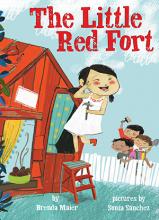
The Little Red Fort
In 1918, the classic tale of The Little Red Hen was printed in book form. A hundred years later, The Little Red Fort presents a beautiful modern spin on the tale. In this version, Ruby makes up her mind to design and build her own fort. Despite a lack of help from her three brothers, she pairs up with supportive family members who allow her creativity and independence to flourish. With repetitive text, readers watch as Ruby’s idea becomes a reality. The initial response of Ruby’s brothers might be a bit predictable, but by the end of the story their response brings a new perspective that satisfies readers of all ages. The book also includes an author’s note and fort construction tips for readers to try on their own.
Tips for Using with Children
There is so much for children to notice, talk about, and enjoy in this updated version of The Little Red Hen. To the readers’ and listeners’ delight, this version retains the original’s use of catchy (in this case also rhyming) phrases. Surely by the third time they have heard the story read dramatically, children will join in and chant: “Not me, said Oscar Lee. I don’t think so, said Rodrigo. No way, said José.” Active listening and emphasizing rhyme becomes pure fun! The reader can also help children focus their eyes on print by pointing to certain words while reading. For example, the repeated phrase, “And she did,” is printed in a large font—point to each word while reading it loudly, and children will join the read-aloud. Partway through the story, try just pointing to the words to encourage the children to do the reading.
Some other ways to extend this story are—noting the details in the pictures, for example some children might notice that the Fort doesn’t become red until after the brothers decide to give a hand; rereading and comparing it to the original Little Red Hen; gathering project scraps and inviting the children to construct their own creations… while practicing helping one another if requested.
Tips for Using with Families
Before looking through this book with families, point out that it is a retelling of a popular folk story—one that was passed down orally rather than in books. Remind families that telling stories is one way families teach children literacy skills (listening, remembering, talking). If there is time, try retelling The Little Red Hen as a group activity. But with or without such an introduction, this vividly illustrated book provides many opportunities for parents and children to have meaningful conversations, and a great chance for parents to be the listeners. There are plenty of illustrated details parents can ask children to interpret, e.g., based on the picture on the first page, “What has Ruby been planning as she plays in the bathroom?” Children might also enjoy figuring out what some of the sayings in the story mean, e.g., “What is a ‘mind full of ideas’” or a look that would ‘melt popsicles?’” Ask children: Can you make your face look like that?
Because of the twists in this new telling of The Little Red Hen, families will be introduced to examples of building supportive family relationships: three generations of a family working together on a project, females succeeding in non-traditional jobs, cooperation among siblings, and as suggested at the end of the book, inviting children to engage in creative play by building their own forts.
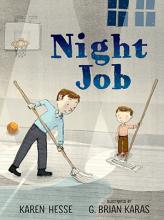
Night Job
When night falls and most are preparing for sleep, a son and his father set out to work the night shift at the local school. As his father cleans the building, the young boy reads aloud to him, plays basketball, and rests on a nearby couch. The connection between them is evident to readers as they complete the important tasks that are part of this shared routine. This quiet yet comforting story illustrates the reality of many families who work at night and shines a light on the companionship of father and son. When their job is completed, the two travel back home to complete their routine and snuggle in for some well-earned rest.
Tips for Using with Children
To engage children in conversations about the story, adults can ask children if they have ever gone to work with a parent or family member. If yes, what were the different roles of the adult and child? Children can connect to the story by talking about the working adults in their lives and by learning more about the workers who help their school or classroom stay clean. Who are the helpers that keep the school running? By making meaningful connections, children build valuable comprehension skills.
Tips for Using with Families
Parents and children can talk about the tasks that make up their daily and nightly routines, and how they are similar or different from those in the story. Encourage families to think about the roles and responsibilities that make up these routines, and talk about ways to build on these tasks so that all family members can feel successful about their contributions.
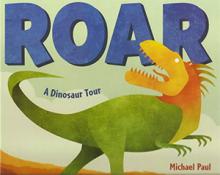
Roar: A Dinosaur Tour
Prepare to tour the world of dinosaurs! This book will delight readers with simple text and interesting facts about these prehistoric creatures. With endpapers that provide a pronunciation guide and nicknames for each dinosaur, young readers will devour this book over and over. Which dinosaurs walked on two legs? Which ones shook the ground when they walked? Was an Iguanodon slow-moving or fast? You can find the answers to these wonders and more when you embark on the dinosaur tour!
Tips for Using with Children
Before reading, show the children the inside cover of the book with pictures of dinosaurs and information about how to pronounce their names. Point to each dinosaur, say its name, and invite children to repeat it with you. Flip to the back page, point to each dinosaur’s nickname, read them aloud and again, invite children to say them with you. During reading, discuss the characteristics of the dinosaurs that the children see in the images (for example, some have spikes, long tails, short snouts, skinny bodies, big teeth, horns, and so on). This deceptively simple, nonfiction text compares the many types of dinosaurs with each other and gives the youngest dinosaur lovers the pleasure of adding to their “dinosaur expertise.” After reading, the children may be invited to share which dinosaur they find the most interesting, find more books about that species, be that dinosaur in dramatic play, and/or write and draw their own small dinosaur books.
Tips for Using with Families
Ask parents about their children’s interest in dinosaurs. Do they have a child who likes to find out everything they possibly can about dinosaurs? Is their child a “dinosaur expert”? Tell parents that a sustained, intense interest in a topic such as dinosaurs helps children to develop their knowledge, improve their attention span, and deepen cognitive growth. Discuss the ways families can support a child’s curiosity about dinosaurs. Some suggestions may be: finding the dinosaur section at the local library, visiting a dinosaur museum, watching specials about dinosaurs on television nature channels, and encouraging children to write about and draw their own dinosaurs. Point out to parents that Roar: A Dinosaur Tour is a book that contains a helpful pronunciation key for dinosaur names in the front inside cover.
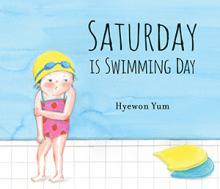
Saturday Is Swimming Day
When the little girl in the story attends her very first swimming class, she has a stomachache and tentatively watches from the side of the pool. With gentle prompts and support from her instructor Mary, she gradually gains the courage to try scoops, kicks, floating, and bobs. With each small yet courageous step, she builds confidence and independence as a new swimmer. All readers who have had to try something new will be able to identify with the main character’s feelings and experiences. This sweet story does a wonderful job of providing reassurance and comfort to younger readers (and their grown-ups) by demonstrating that, with the help of a little patience, practice and support, there is a promise of success.
Tips for Using with Children
Before reading this story aloud, point out to the children that the story starts before the first page, where clues about what the story may be about can be found. The first page shows a calendar with all of the Saturday dates circled in red. Ask the children if their families keep track of events on a calendar. On the double-page title spread, the illustration shows a little girl looking at a big pool of water. Invite the children to make some predictions about the story and the little girl. After listening to the children’s suggestions, turn the page to the beginning of the story, and ask children to think about a time they may have been afraid to do something. While reading the story, stop to view the illustrations and listen to children’s observations or questions along the way. After reading, talk with the children about how the little girl was able to overcome her fear and enjoy swimming. Ask children: How could you tell that the little girl was comfortable with the water and swimming? (Word and picture clues point to answers.) How did the teacher in the story help her along the way?
Tips for Using with Families
After reading the book aloud, reflect with parents on the ways the swimming teacher, Mary, built trust with, was supportive of, and eventually helped the little girl overcome her fear. Suggestions may include: the teacher was patient and didn’t push the little girl into doing something she wasn’t ready to do; the teacher helped the little girl experience success by mastering one little step and then working on the next small step; the teacher allowed the little girl to participate in the activities in an adapted way (for example, the other children in the class practiced their kicks independently, while Mary held the little girl as she practiced her kicks in the water), and so on…
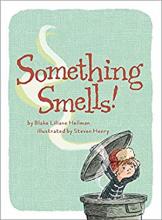
Something Smells!
When Elliot wakes up and smells something stinky, he investigates all of the possible culprits: a skunk outside, the dog’s food, and even his grandma’s cooking. However, nothing he finds seems to be the source of the terrible smell. The mystery continues throughout the story, even showcasing a double-page spread that retraces the steps of Elliot’s search. Readers will love the reveal at the end of the book, especially if they figure out the source of the smell before Elliot does!
Tips for Using with Children
Children will delight in and laugh aloud at this funny story about a terrible smell that Elliot wakes up to and is determined to identify. Allow the children to make spontaneous observations throughout the reading of the story. At the end of the story, invite children to retell it in their own words by looking at the picture clues. After hearing and retelling this story, it is one that children will want to share with family and friends.
Tips for Using with Families
Something Smells! is a humorous story that will be enjoyed by all ages. Talk with families about stories that children will want to hear read over and over again for the pure pleasure of it. Share that when children want to hear a book read multiple times they are finding comfort in the familiar, they begin to remember the sequence of the story, they build their vocabulary, and it won’t be long before they are reading the book on their own.
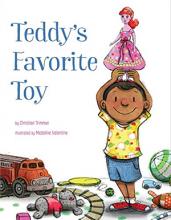
Teddy’s Favorite Toy
Teddy has a variety of cool toys, but his favorite is Bren-Da, Warrior Queen of Pacifica. She is polite, has a unique fashion sense, and displays some fierce moves when called to action. When Bren-Da is in trouble, however, Teddy realizes that she isn’t the only person in his life with warrior qualities. Teddy’s mom leaps into action, and readers will be filled with excitement and emotion as they await Bren-Da’s fate. Readers won’t want to miss out on this heartwarming story of the bond between a mother and son.
Tips for Using with Children
When reading to groups of children, adults can take time to discuss the events in the story. Adults can direct children’s attention to the pages that include thought bubbles, and explain that Teddy’s mom is recalling her actions from earlier in the day and realizing what happened to Bren-Da. Adults can invite children to use props and their imaginations to grant superpowers to a stuffed animal or toy from home or the classroom. Children will enjoy narrating their toy’s special skills.
Tips for Using with Families
Parents can prompt open conversations with children throughout this story. On several pages, thought bubbles, as well as the expressions on the characters’ faces, tell the reader about key events. Children may need extra time to observe and talk about what is happening and what might happen next. Talk with parents about the messages within the book that they observe. Are there similarities between Bren-Da and Teddy’s mom? Has their child ever had an attachment to a favorite toy? Does the loss of Bren-Da’s leg affect her ability to be a warrior?
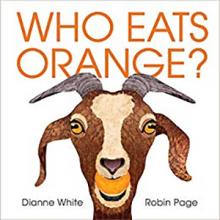
Who Eats Orange?
Vibrant illustrations and question and answer text capture the reader’s attention, starting with the title: Who Eats Orange? This book not only covers a variety of colors of foods, but also integrates new vocabulary and less common animals, such as toucans, waxwings, and grunts. At the end of the book, the author includes more details about each featured animal and the foods they eat, using categorization based on where they live. Readers will savor this nonfiction book that encourages them to think about the rainbow of foods that humans eat. Curious who else eats orange besides you? Read to find out!
Tips for Using with Children
Did you know that bears can have black, brown, or even bluish fur, or that zebras are not picky eaters? Adults can use the additional information in the back of the book to integrate interesting facts like these into their story time. This book can be used in a variety of ways based on the age and interest of the audience, and adults can focus on different areas of learning such as colors, animals, habitats, foods, and more. As an extension activity, children could taste test some of the colorful foods featured in the story.
Tips for Using with Families
Parents can draw their child’s eyes to the images in this book by pointing to the pictures and by asking questions about the animals, foods, and colors they see on the pages. Prior to reading, it might be helpful for an adult to preview the additional information in the back of the book. This information is color-coded and key vocabulary appears in bold to highlight interesting facts. If children have a question that an adult cannot answer, parents can model research strategies by looking in the back of the book or searching online.
